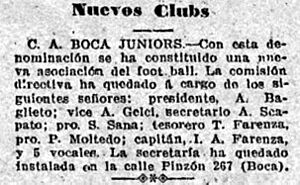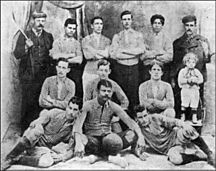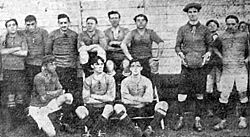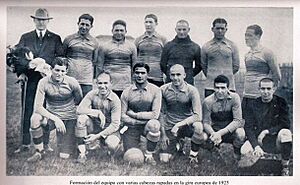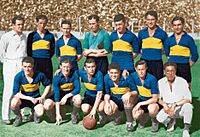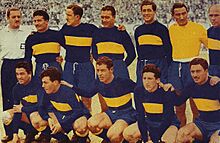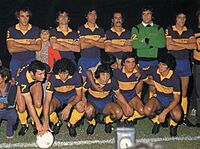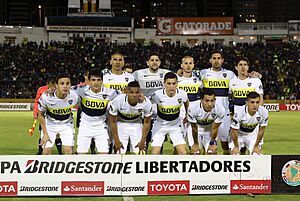History of Boca Juniors facts for kids
Boca Juniors is a famous Argentine sports club that started in the early 1900s. A group of teenagers decided to create a football team in La Boca, a working-class area of Buenos Aires. Many of the club's founders were from Italy. This was because many people from Liguria, Italy, had moved to this part of Buenos Aires in the 1800s. Even today, Boca fans are called "Xeneizes," which means "Genoese" in the Ligurian language.
In its early years, Boca Juniors developed a strong rivalry with a nearby team, River Plate. This rivalry continued even after River Plate moved away from La Boca. In the 1900s, Boca became one of Argentina's most popular and successful clubs. Their first big step was in 1913 when the team moved up to the top league, Primera División.
Boca Juniors won its first official title in 1919. This was the Primera División championship. A very important moment for the club happened in 1925. Boca Juniors went on a successful tour to Europe. They played 19 matches and won 15 of them. This was the first time an Argentine team played abroad. The tour helped Boca gain many more fans in Argentina. During this tour, the term "player number 12" was first used for their loyal fans.
Before their famous stadium, La Bombonera, opened in 1940, Boca Juniors played in many different places. Their first field was in Dársena Sud, south of the current Puerto Madero area. They also played in Isla Demarchi and Wilde in Avellaneda Partido. Their first stadium in La Boca was at Ministro Brin and Senguel streets. They stayed there until 1924, then moved to Brandsen and Del Crucero.
While football was the main sport, Boca Juniors also added other sports. These included basketball and volleyball. The basketball team has won many titles since it started in 1929. In football, Boca Juniors has been known as one of the "Big Five" clubs since 1937. This was when the Argentine Football Association (AFA) set up a system for clubs to be represented.
Contents
- How Italian Immigrants Shaped Argentina
- The Club's Beginning
- First Years of Play
- Joining the AFA
- Reaching the Top League and the "Superclásico"
- First Titles and Success
- European Tour: "Champion of Honour"
- The 1930s: A New Era
- The 1940s: More Trophies
- The 1950s and the Great 1960s
- 1970s: The Second "Golden Age"
- 1980s: Maradona and Fewer Titles
- Early 1990s: International Success and New Leadership
- The Bianchi Era: Another Golden Age
- Basile's Multi-Champion Team
- More International Success
- 2010s: Local Success Continues
- The Barros Schelotto Era
- Recent Years
- See also
How Italian Immigrants Shaped Argentina
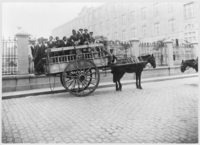
By 1905, Buenos Aires had about 900,000 people. Many of them were Italian immigrants. They arrived in large numbers from 1870 to 1920, with the most coming between 1900 and 1915. Most of them settled in the Buenos Aires Province. They worked in many jobs, like agriculture, craft, and commerce.
By 1914, half of all immigrants who came to Argentina were Italian.
Italian immigrants living in La Boca tried to keep their traditions. "cantinas" were places where they met and danced to Italian music. They also brought their food from Italy, like pizza and pasta.
Italian influence is still strong in Argentina. For example, "Lunfardo" is a special way of speaking found in tango songs. It has many Italian words. Common dishes with Italian names like milanesa, fainá, polenta, and pascualina are now popular Argentine foods.
The Club's Beginning
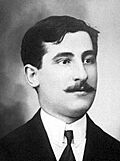
On April 1, 1905, a group of boys who had played for a team called "Independencia Sud" met. They sat on a bench in Plaza Solís in La Boca. Their goal was to start a new football team. The boys were Esteban Baglietto, Santiago Scarpatti, Santiago Sana, and the brothers Juan and Teodoro Farenga. They couldn't agree that day, so they met again the next day.
On April 3, they finally agreed and formed the first committee. Esteban Baglietto became the first president. They suggested many names. "Boca" was chosen for the neighborhood. Santiago Sana suggested adding "Juniors" to make the name stand out. Using English words in football team names was common then. This was because British railway workers first brought football to Argentina.
Plaza Solís is now known as the place where Boca Juniors was founded.
Baglietto, Sana, and Scarpatti had learned football from Patrick "Paddy" McCarthy. He was an Irish footballer and boxer who came to Argentina in 1900. He taught football skills to immigrant children.
Other important founding members included Arturo Penney, Marcelino Vergara, Luis Cerezo, Adolfo Taggio, Giovanelli, Donato Abbatángelo, and Bertolini.
First Years of Play
The club's first field was in "Dársena Sud." It was located near Pedro de Mendoza, Colorado (now A. Caffarena), Sengüel (now B. Pérez Galdós), and Gaboto streets. The club's office was on Pinzón street, later moved to Suárez street. On April 21, 1905, Boca Juniors played its first match. They beat Mariano Moreno 4–0. Juan Farenga scored two goals, and José Farenga and Sana scored one each.
The first team included: Esteban Baglietto (founder and president); José Farenga (founder and treasurer), Santiago Sana, Vicente Oñate, Guillermo Tyler, Luis De Harenne, Alfredo Scarpatti (secretary), Pedro Moltedo (captain), Amadeo Gelsi (vice-president), Alberto Tallent, and Juan Farenga (founder). For this match, the team wore a white shirt with black stripes. Manuela, the Farenga brothers' sister, sewed it by hand. This shirt was used for several games before being replaced by a light blue one. Some stories say the first jersey was pink and only worn for two games, but there's no strong proof.
In August 1905, Boca joined the Copa Villalobos. The team did not play well, losing most of its games. One of their opponents was Club Atlético Independiente. After this tough experience, Boca Juniors joined another league, "Liga Central," in 1906. There, the team won its first title, the "Copa Reformista Trophy." Boca played 18 matches, winning 15 and remaining unbeaten.
In 1907, the club played two matches in Liga Central before moving to "Asociación Porteña de Foot-Ball." Some sources say Boca wore the blue and gold colors for the first time on August 4. This was against General Arenales, a game Boca won 1–0. These colors came from a suggestion by Juan Brichetto, a former club president and port worker. He suggested taking the colors of the flag of the first ship he saw cross the bridge the next morning. The first ship was Swedish, so Boca Juniors chose those colors.
It is thought that the ship was the 4146-ton freighter "Drottning Sophia," a Swedish vessel from Copenhagen. However, some historians say the Drottning Sophia arrived in Buenos Aires in 1905, not 1907. The ship that gave Boca Juniors its colors was probably the Oskar II of Nordstjernan/Johnson Line, which arrived at the port on February 5, 1907. The first design with these colors was blue with a diagonal gold stripe.
In Asociación Porteña, Boca reached the final against Araneles. They lost the playoff 1–0 after their first match (which Boca won 4–1) was canceled, and the second ended in a 3–3 tie. In September, Boca joined Liga Albión. One of their rivals there was Santa Rosa, which later became arch-rival River Plate. That year, Boca played its first international match. It was against Uruguayan club Universal from Montevideo on December 8, 1907. Universal won 1–0.
Boca Juniors played the 1907 Copa Albión final against San Telmo in 1908. They won 4–1, earning their second title, the "Copa Barone Trophy."
Joining the AFA
In 1908, Boca Juniors joined the Argentine Football Association. They played in Segunda División, which was the second division of Argentine football at the time. Boca Juniors' first official tournament match was on May 3, 1908. The team beat Belgrano A.C. II 3–1. This game was played in the stadium at Virrey del Pino and Superí in the Belgrano neighborhood.
The starting team for that historic match was: Juan de los Santos; Marcelino Vergara, Luis Cerezo; Guillermo Ryan, Alberto Penney, Juan Priano; Arturo Penney, Manuel Eloiso, Rafael Pratt, Pedro Moltedo, José María Farenga. Pratt scored two goals, and Eloiso scored one. The team finished first among eight teams. They moved to the semifinal, where Racing Club beat Boca 1–0.
On August 2, the first friendly Superclásico (the famous rivalry match) was played. Boca won 2–1. However, some sources say there were earlier matches between the two clubs. That same year, Boca Juniors played its first Copa Bullrich. This competition was for Segunda División clubs. Boca was knocked out by Atlanta (who later became champion) in the second stage, losing 5–0.
In 1909, Boca had a weaker season, finishing 3rd in their group. Gimnasia y Esgrima de Buenos Aires moved up to Primera División. In 1910, Boca Juniors had a good season, winning 15 matches and losing only 3. Boca played another semifinal against Racing Club but lost 2–1. They could not move up to the first division.
In 1911, the División Intermedia was created as the second level of Argentine football. Boca Juniors was one of the teams in it. The club had a poor season, with only 7 wins and 8 losses. They almost got sent down to a lower league. Pedro Calomino, who became the first star in the club's history, played his first game during this competition.
Boca left its field in 1912 and moved to Costanera Sur. This is where the Naval Observatory is today. Because of a split in the Football Association, a new group called Federación Argentina de Football was formed. This meant only a few clubs played in the championship. Boca was promoted to the first Division the next year, along with other teams.
Reaching the Top League and the "Superclásico"
In 1913, Boca finally moved up to the Primera División. This was possible because the Asociación Argentina de Fútbol decided to increase the number of teams in the league from 6 to 15. Other teams that also moved up were Ferro Carril Oeste, Platense, Banfield, Olivos, Comercio, Ferrocarril Sud, and Riachuelo.
Boca Juniors finished 5th in its first season in Primera División. They played 14 matches, winning 8, losing 4, and drawing 2. They scored 29 goals and let in 16. The next season, Boca Juniors finished 3rd out of 13 teams. In the 1915 championship, the team's performance dropped a lot. They finished 14th out of 25 teams. They also suffered big losses to Racing Club (0–6) and San Isidro, who were the two best teams. The loss to San Isidro is still their worst defeat in official matches.
The first official match between Boca Juniors and their big rival River Plate, known as the Superclásico, was played in the 1913 Primera División championship. It was at Racing Club stadium, and River Plate won 2–1. Boca had played River in other unofficial matches before, but the exact dates are still debated. The most common story says the first Superclásico was on August 2, 1908, with Boca Juniors winning 2–1. However, there are no documents to prove this. Another story says the first recorded match was in 1912.
First Titles and Success
In 1919, the Football Association removed 7 clubs. Another 6 clubs left to form the Asociación Amateurs de Football. The ongoing championship was canceled, and a new competition with only 6 teams was organized, including Boca Juniors.
Boca Juniors won its first title ever: the 1919 Primera División championship. The team won all its matches, scoring 29 goals and only letting in 5. The starting team for the last game was: Tesoriere; Cortella, Ortega; López, Busso, Elli; Calomino, Bozzo, Garasini, Martín, Miranda. The game was played at Boca Juniors stadium. Boca beat Sp. Almagro 4–0, with Martín and Miranda scoring two goals each.
That same year, Boca won three more titles. These were the national cups Copa de Competencia Jockey Club and Copa Ibarguren. Both were against Rosario Central with a score of 1–0. They also won the last edition of the international Tie Cup. They defeated Uruguayan team Nacional 2–0 at Estadio Sportivo Barracas. Miranda and Bozzo scored the goals. Because of these wins, 1919 is still the most successful season in the club's history. They won 4 titles: 1 league, 2 domestic cups, and 1 international cup.
The 1920s were also very successful for the club, as they won 9 titles. They won their second league title in a row in 1920. In the 18th round, Boca beat Nueva Chicago 7–0 on December 19. Boca played 24 games, winning 20 and losing only 1.
In 1923, Boca won its third Primera División title. In this championship, 4 matches had to be played to decide the champion between Boca and Huracán. Boca won the first game but lost the second. The third match was a tie. So, a fourth game was played at Estadio Sportivo Barracas stadium on April 27, 1924. Boca finally won 2–0, taking the title. Both goals were scored by Garasini.
In 1923, Boca also won the 1920 edition of Copa de Honor Cousenier. They beat Universal FC 2–0 in Montevideo. This was their first title won outside Argentina. Also in 1923, Boca won its second Copa Ibarguren. They defeated Rosario Central (the same team Boca had beaten in 1919) 1–0 at Sportivo Barracas.
Boca was the unbeaten champion of the 1924 season. They won 18 out of 19 matches. The team scored 67 goals (an average of 3.52 per game) and only let in 8. That same year, Boca Juniors won its third Copa Dr. Ibarguren. They beat Rosario Central 5–1 at Chacarita Juniors stadium.
European Tour: "Champion of Honour"
In 1925, Boca made its first trip to Europe. They played in Spain, Germany, and France. The team played 19 games and won 15 of them. They defeated famous teams like Real Madrid, Celta de Vigo, and Deportivo La Coruña. On June 28, 1926, the Association Argentina de Football declared Boca Juniors "Campeón de Honor" (Champion of Honour) for the 1925 season. Each player received a special medal.
After their successful European tour, Boca Juniors returned to local competitions. They won their 5th Primera División championship in 1926. They finished unbeaten, just like in the 1924 season, after 17 games. Boca Juniors and Independiente were supposed to play a final match to decide the unified title. This was after the two leagues (Asociación Argentina de Football and Asociación Amateurs de Football) joined together. However, their match on February 20, 1927, was stopped because fans invaded the field. A replay on March 3, 1927, ended 0–0. No further match was played because the new season started.
Boca not only won the league championship but also another Copa de Competencia Jockey Club. They beat Argentinos Juniors in the second match after the first game was a draw. In 1926, Boca Juniors also won another national cup, the Copa Estímulo. This was played while the Argentina national football team was at the South American championship. Boca defeated Sportivo Balcarce 3–0 in the final.
Boca Juniors ended the 1920s as one of the most successful teams of the decade. They won 4 league titles and 4 national cups during that time.
The 1930s: A New Era
After losing the 1929 championship to San Lorenzo de Almagro, Boca won its 6th title in 1930. The team defeated Atlanta 4–1, with just two games left in the season.
With professional football starting in Argentina, Boca won its 7th league championship in 1931. They beat their main rival, River Plate, 3–0 in the last game. Boca earned 50 points, with 22 wins, 6 draws, and 6 losses.
In 1934, Boca won another title. Even though the team lost 7 matches and let in 62 goals, they became champions in round 38. They defeated Platense 5–1. The key to their success was their strong attackers, who scored 101 goals. Boca Juniors was the first team to score more than 100 goals in the league.
When they won the 1935 season, Boca became the first team to win two championships in a row in the professional era. The team also scored 100 goals and only let in 29. Boca Juniors became champions in the 33rd round after defeating Tigre 3–0.
During the 1930s, players like Juan Yustrich (called El Pez Volador -The Flying Fish), Pedro Arico Suárez, Delfín Benítez Cáceres, Domingo Tarasconi, Roberto Cherro, and Francisco Varallo were not only big stars but also great heroes for Boca Juniors.
The 1940s: More Trophies
Boca won three league championships in the 1940s, just like in the previous decade. The first title was in 1940. This was the same year that La Bombonera stadium opened. The most important match was against Independiente, which Boca won 5–2, becoming champions. Boca won 24 games, drew 7, and lost 3. That same year, Boca Juniors won the Copa Ibarguren (their 4th) after beating Rosario Central 5–1 at Chacarita Juniors stadium.
In 1944, Boca won its second championship in a row. They defeated Racing 3–0 in the last game. The game was played at River Plate stadium. This was because the Bombonera was temporarily closed due to incidents with fans. Out of 19 games, Boca Juniors won 19, drew 8, and lost 3. The team for that match against Racing is still remembered as one of Boca's best teams ever. During that season, Boca also went unbeaten for 26 matches in a row. This was a record in the professional era until Racing broke it in 1966 by playing 39 matches without losing.
In 1944, Boca Juniors also won its 5th Copa Ibarguren. They beat the Tucumán combined team 3–0.
Boca Juniors won another National cup in 1946, the Copa de Competencia Británica. They defeated San Lorenzo 3–1, again playing at River Plate stadium.
However, Boca was almost sent down to Segunda División in 1949. But they managed to stay in Primera with a big win over Lanús in the last game. This was the first time Boca finished last in any Primera División season.
The 1950s and the Great 1960s
In 1954, Boca won its first title after nine years without one. The key match was against Huracán, which Boca won 3–1 to secure the championship. The top scorer was José "Pepino" Borello with 19 goals. Another great player was Julio Musimessi, known as "El arquero cantor" ("The singer goalkeeper").
Boca finished 8th in 1959. However, the team won both "Superclásicos" that year (5–1 and 3–2 after being down 2–0).
On December 9, 1962, Boca won a famous match, defeating River Plate 1–0. The highlight was goalkeeper Antonio Roma stopping a penalty kick by Delem with only 6 minutes left. Boca finally won its first title of the decade in the next game with a big 4–0 victory over Estudiantes de La Plata, becoming the new champion. During the 1960s, Boca Juniors won 5 championships.
The next title was in 1964. Antonio Roma did not let in a goal for 742 minutes and only conceded one goal in 14 matches. In 1965, Boca won championships two years in a row for the 3rd time in the professional era. The important matches were the victory over River Plate (2–1) and Atlanta in the last game.
In the 1968 Metropolitano championship, during a Superclásico that ended 0–0, a sad event happened. Seventy-one Boca Juniors fans died after being crushed against an exit door at River Plate Stadium. The door was closed when fans tried to leave. This event is still remembered as The Tragedy of the Door No. 12.
In 1969, an official tournament called Copa Argentina was played. Teams from the Metropolitano and outside Buenos Aires took part. Boca Juniors became champions after beating Atlanta on goal difference (the matches were 3–1 and 0–1). Boca Juniors played 10 matches, winning 7, drawing 1, and losing only 1.
That same year, Boca played its last match of the Nacional championship visiting River Plate at the Monumental. The match ended 2–2, with Norberto Madurga scoring twice. This made Boca the new champion. The Xeneizes (Boca's nickname) had 29 points, winning 13 games, drawing 3, and losing only 1. They were coached by Alfredo Di Stéfano.
1970s: The Second "Golden Age"
In 1970, Boca won another title, defeating Rosario Central in the final match of the Nacional tournament. In 1976, Juan Carlos Lorenzo joined the club. He became one of the most successful coaches in Boca Juniors' history, winning 5 official titles in 3 years. The first was the 1976 Metropolitano. Boca won this after defeating Unión de Santa Fe 2–0, one game before the end of the tournament.
In the next tournament (1976 Nacional), Boca played a historic final match against their big rival River Plate. They won 1–0 with a direct free kick goal scored by Rubén Suñé. This was the only final played by both Superclásico teams until today.
That championship allowed Boca Juniors to play in the 1977 Copa Libertadores. They reached the final against Cruzeiro. After winning 1–0 in Buenos Aires and losing 1–0 in Belo Horizonte, a third game was needed. It was held in Estadio Centenario in Montevideo. Boca finally won the Libertadores for the first time after a dramatic penalty shootout. Hugo Gatti stopped the last shot by Brazilian player Vanderley after the match ended 0–0.
The next title, and the most important of the decade, was the 1977 edition of the Intercontinental Cup. This was against German club Borussia Mönchengladbach and was played one year later. The first game in Buenos Aires in March 1979 ended 2–2. But Boca won the second game (played more than four months later, on August 1 in Karlsruhe) 3–0. They brought the trophy back to Argentina.
To finish a decade full of achievements, Boca Juniors won its second Copa Libertadores in 1978. They defeated Deportivo Cali (coached by Carlos Bilardo) 4–0 in La Bombonera on November 28. The first match in Colombia had ended 0–0.
1980s: Maradona and Fewer Titles

After a season in 1980 where club legend Antonio Rattín was the manager, the big event of the 1980s was when the amazing player Diego Maradona joined the club. He came with Miguel Brindisi, Osvaldo Escudero, and Marcelo Trobbiani. Another club legend, Silvio Marzolini, became the coach. Boca won its first title of the decade, the 1981 Metropolitano championship. They secured it after a 1–1 draw against Racing in the 17th round. Maradona and Brindisi were seen as the most important players on the team.
The next year, Boca lost the young Maradona, who moved to Europe to play for FC Barcelona. In 1984, Boca had some money problems. The same year, the team lost very badly to FC Barcelona, 1–9, in a friendly competition called Joan Gamper Trophy. After Marzolini left in 1981, Boca Juniors had many different coaches. But the team could not win any titles until 1989.
In 1985, Antonio Alegre and Carlos Heller were chosen as president and vice-president. They helped the club fix its money problems. Boca also sold some land they owned for a lot of money.
The club's better finances led to its comeback. Boca started winning important tournaments again. The 1989 Supercopa Libertadores was the last title of the decade. They beat Independiente in a penalty shootout after both games ended 0–0. The team, managed by Carlos Aimar, won its first international trophy since the 1978 Copa Libertadores.
Early 1990s: International Success and New Leadership
Boca Juniors won more international titles in the early 1990s. They won the 1990 Recopa Sudamericana, the 1992 Copa Master de Supercopa, and the 1993 Copa de Oro (named "Nicolás Leoz"). In Argentina, the team won the famous 1992 Apertura. This was after eleven years without winning a league title. The team was managed by Uruguayan Óscar Tabárez, who joined the club in 1991.
Some of the most important players from the late 1980s and early 1990s were Carlos Navarro Montoya (who played many games for the club), Diego Latorre, Gabriel Batistuta, Juan Simón, Carlos Mac Allister, Carlos Tapia, Blas Giunta, Claudio Marangoni, Sergio Martínez, Alberto Márcico, and Roberto Cabañas.
In 1995, businessman Mauricio Macri was elected as the club's president. One of his first actions was to improve La Bombonera stadium. He also built a basketball venue, Estadio Luis Conde (known as La Bombonerita), which opened in 1996. Macri also created a special fund to buy football players. He also hired Jorge Griffa to manage the youth teams. The goal was to develop new talented players from Boca Juniors instead of buying them from other clubs.
The first manager under Macri's presidency was Carlos Bilardo, a former Argentina national team coach. He stayed for only one year and didn't win any titles. This was despite many players being bought, including Diego Maradona (who had returned to the club), Claudio Caniggia, Juan Verón, Kily González, Fernando Gamboa, and Néstor Fabbri. Bilardo resigned after Boca Juniors finished 10th in the 1996–97 season. Héctor Veira took over, but he also couldn't win any titles. His team's best performance was finishing second in the 1997 Apertura.
The Bianchi Era: Another Golden Age
Former Vélez Sársfield coach Carlos Bianchi joined the club in 1998. Under his leadership, the team won many local and international titles. They broke the record set by Juan Carlos Lorenzo in the 1970s. With Carlos Bianchi as coach, Boca won 9 titles.
The first title was the 1998 Apertura, which Boca won without losing a single game for the first time. Martín Palermo was the top scorer with 20 goals in 19 matches. Boca then won another championship in the 1999 Clausura, becoming champions two years in a row. The team went unbeaten for 40 matches, breaking the record of 39 matches set by Racing Club in the 1960s. This is still a record in the professional era of Argentine football.
The year 2000 was the most successful for Boca Juniors. The team won the Copa Libertadores after 22 years. They defeated Palmeiras in the finals in a penalty shootout after two games ended in a draw (2–2 and 0–0). Goalkeeper Oscar Córdoba was the most important player in the final played in São Paulo. As the new South American champion, Boca went to Tokyo to play the 2000 Intercontinental Cup against Real Madrid. They defeated the Merengue team 2–1, with goals by Palermo. That same year, Boca won another local title, the Torneo Apertura, making it 3 titles in 2000.
In 2001, Boca won the Copa Libertadores again, defeating Cruz Azul in a penalty shootout. Boca won the first final match 1–0 in Mexico and lost the second game in La Bombonera by the same score. Oscar Córdoba was again the most important player.
Bianchi left the club in 2002 due to a disagreement with the chairman Mauricio Macri. So, Oscar Tabárez was chosen as his replacement, starting his second time as the team's coach. However, Bianchi returned the following year to coach the team again. In 2003, Boca won a new title, the Copa Libertadores, for the 3rd time in 4 years. The most important player of that tournament was Carlos Tevez, while Marcelo Delgado was the top scorer with 9 goals. In the finals against Santos FC, Boca won 2–0 in Buenos Aires and 3–1 in São Paulo. Boca Juniors had another successful year, winning the 2003 Intercontinental Cup against AC Milan in a penalty shootout after a 1–1 draw. Matías Donnet, who tied the game, was named the Man of the Match.
Boca reached another Copa Libertadores final in 2004 but lost to Once Caldas from Manizales, Colombia in penalty kicks. After the Cup, Bianchi resigned, ending one of the most successful times in the club's history.
Basile's Multi-Champion Team
After Bianchi left the club, Miguel Brindisi (who had played for the club in the 1980s) was chosen as coach. But he soon resigned at the end of the 2004 Apertura, when Boca finished 8th. The next coach was Jorge Chino Benítez, another former Boca player from the 1970s and 1980s. Under his coaching, Boca won the 2004 Copa Sudamericana, defeating Club Bolívar in the finals.
In 2005 (the year of Boca's 100th anniversary), the Xeneize played in another Copa Libertadores. They were eliminated by Chivas de Guadalajara. In that match, Benítez had an incident with a Chiva's player, which caused a small fight. Because of this, Benítez was immediately removed from the club. After Benítez's dismissal, Boca hired Alfio Basile as its coach.
With Basile as coach, Boca won the Recopa Sudamericana (2005 edition), defeating Once Caldas. They also won the 2005 Copa Sudamericana, where the Xeneize beat Pumas from México in a penalty shootout after two draws. Roberto Abbondanzieri was the best player, stopping two shots and scoring the winning penalty. Boca would win two more titles: the 2005 Apertura and 2006 Clausura, becoming champions of Argentina two times in a row. The team also won the 2006 Recopa Sudamericana against São Paulo.
After the Argentina national football team was eliminated from the 2006 World Cup, Basile was asked by the National Association to coach the national team. He left Boca Juniors during a very successful period. Under Basile's coaching, Boca Juniors won five titles in two years (2005–06).
More International Success
Ricardo Lavolpe was chosen to be the coach after Basile. In the 2006 Apertura, the team played well. But at the end of the season, they had the same number of points as Estudiantes de La Plata. So, both teams had to play a match to decide the champion. Estudiantes defeated Boca 2–1 at Vélez Sársfield stadium, and Lavolpe resigned as coach.
The next coach was Miguel Ángel Russo, and Juan Román Riquelme returned to the club. Boca Juniors won the 2007 Copa Libertadores, defeating Brazilian team Gremio in the finals (3–0 in Buenos Aires and 2–0 in Porto Alegre). Riquelme, who scored 8 goals, was considered the best player of the tournament by journalists and fans. As the South American champion, Boca went to Tokyo to play the FIFA Club World Cup. But they were defeated by Italian AC Milan 4–2.
Carlos Ischia was appointed as coach after Russo left. Under his coaching, the club won the 2008 Recopa Sudamericana (against Arsenal de Sarandí). However, Boca was eliminated by Fluminense (who would be the runner-up) in the 2008 Copa Libertadores semi-finals. At the end of that year, Boca won a new title, the 2008 Apertura. That season ended with Boca, San Lorenzo, and Tigre all tied for 1st place. So, a playoff tournament had to be played among those 3 teams to decide the champion. Boca won that tournament and became the new Argentine champion. That same season, Boca's big rival River Plate finished last for the first time in its history.
Boca finished 14th (out of 19 teams) in the 2009 Clausura. Ischia was dismissed by the club (though the managers said he had resigned). Basile was called to start his second time as coach. However, after finishing 11th in the 2009 Apertura, Basile left the club.
2010s: Local Success Continues
For the 2010 Clausura, the team was coached first by Abel Alves and then by Roberto Pompei. They were working with the youth teams when they were asked to coach the first team. Boca finished 16th, so the club decided to hire Claudio Borghi. He had won a title coaching Argentinos Juniors the last season. But he left the club after 14 matches because of bad results. Roberto Pompei was chosen to be the coach until the end of the Apertura. Boca finished in 12th position.
In January 2011, Boca hired Julio Falcioni, who had won a title coaching Banfield in 2009. The team did not have a good season in the Clausura. However, Boca won the Superclásico (the last one played before River was sent down to the second division). They finished 7th. In the last game (when Boca played against Gimnasia y Esgrima de La Plata), Martín Palermo, the club's all-time top scorer, retired.
For the 2011 Apertura, Boca got goalkeeper Agustín Orión and experienced defender Rolando Schiavi, who returned after playing for Newell's Old Boys. After three years without any titles, Boca won its 30th league title. They defeated Banfield 3–0 in round 17. Boca Juniors finished the tournament unbeaten, with 12 wins and 7 draws. The team also let in the fewest goals (only 6 in 19 matches). This set a record for short tournaments in Argentina. That same season, Boca also won the second edition of the relaunched Copa Argentina, after beating Racing Club in the final.
In 2012, Boca reached the final of Copa Libertadores. This was five years after winning the 2007 final. But the team lost to Brazilian Corinthians 3–1 over two games. In the knockout stages, the team had previously beaten Unión Española, Fluminense, and Universidad de Chile.
In 2013, it was confirmed that Carlos Bianchi, the most successful coach in Boca Juniors' history, would return to coach the team again. On August 28, 2014, after 74 matches with only 45 percent wins (26 wins and losses), and without any championships, Bianchi was dismissed by the club.
After Bianchi was dismissed, former player Rodolfo Arruabarrena was hired as the club's manager. With Arruabarrena as coach, Boca Juniors reached the semifinals of the 2014 Copa Sudamericana. But they were defeated by River Plate (0–1 over two games). The next year, Boca Juniors was disqualified from the 2015 Copa Libertadores by CONMEBOL. This was due to a controversial incident involving chemicals thrown at River Plate players during the match at La Bombonera. Before these incidents, Boca Juniors had won all their group stage games.
After the disappointment in the Copa Libertadores, Boca won its 31st league title, the 2015 Primera División. This happened on November 1, when the team defeated Tigre in the second-to-last game with a goal scored by Fabián Monzón. Carlos Tévez (who had left Juventus to join Boca Juniors at the beginning of that year) was the key player of the team. Only three days after winning the Primera División title, Boca Juniors won the 2014–15 Copa Argentina. They beat Rosario Central 2–0 (goals by Lodeiro and Chávez) in a match played in Córdoba.
The Barros Schelotto Era
On February 29, 2016, Arruabarrena was dismissed as Boca Juniors manager. He had coached the team for 75 games, winning 47, drawing 13, and losing 15. On March 1, Guillermo Barros Schelotto was announced as the new manager. This was his third time managing a professional football team. He returned to the club after playing for them between 1997 and 2007, where he won 16 titles.
Under Barros Schelotto's coaching, Boca reached the semifinals in the 2016 Copa Libertadores. They beat Uruguayan Nacional in a penalty shootout. But the team was eliminated by Ecuadorean Independiente del Valle after losing both games (1–2 and 2–3). In Argentina, Boca Juniors won its 32nd league title, the 2016–17 Primera División. The team became champions on June 20, 2017, even before playing their 29th game against Olimpo. Boca had 63 points in 30 matches, 7 points more than River Plate, who finished second. Also, Benedetto was the top scorer of the competition with 21 goals.
Boca Juniors won its second league title in a row in 2017–18. They had 58 points from 27 matches. Boca became champions after a 2–2 tie with Gimnasia y Esgrima LP in round 25.
In November 2018, Boca played in a Copa Libertadores final after 6 years. The team had previously beaten Brazilian clubs Cruzeiro and Palmeiras. In the finals, Boca lost to River Plate (5–3 over two games). Because of incidents by River supporters before the second game at Estadio Monumental, the match was stopped. It was rescheduled for December 9, 2018, at Santiago Bernabeu Stadium, where Boca was beaten by its classic rival.
Recent Years
In 2019, Gustavo Alfaro was appointed as the team's manager. With him, Boca won the 2018 Supercopa Argentina after beating Rosario Central 6–5 in a penalty shootout. This was the only title won with Alfaro. That same season, Boca lost the 2019 Copa de la Superliga to Tigre (0–2). It was also Tigre's first title in the top division. Boca Juniors was also eliminated from 2018–19 Copa Argentina after losing to Almagro 3–1 on penalties.
In 2019 Copa Libertadores, Boca was eliminated by River Plate on goal difference (1–2 over two games). In December 2019, Jorge Amor Ameal was elected as president. Media businessman Mario Pergolini and former star Román Riquelme became vice-presidents. Gustavo Alfaro left the club after his contract ended on December 23. He was replaced by Miguel Ángel Russo, who started his second time as manager of the team.
The first title with Russo came in March 2020. Boca Juniors won the 2019–20 Primera División in the last game. The team beat Gimnasia y Esgrima LP (coached by Diego Maradona) 1–0. Boca Juniors won the match while archrival River Plate tied 1–1 with Atlético Tucumán. So, Boca won its 34th league title, with a total of 48 points.
See also
 In Spanish: Historia de Boca Juniors (fútbol) para niños
In Spanish: Historia de Boca Juniors (fútbol) para niños


